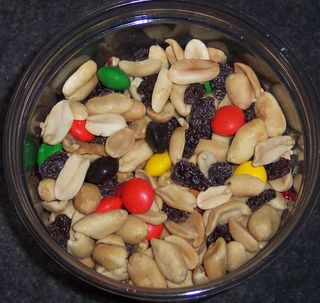Health
10 Delicious "Exercise Snacks" for Fun and Fitness
The idea of "exercise snacks" can break down mental barriers to being active.
Posted January 29, 2019 Reviewed by Ekua Hagan

Snack Your Way to Fitness!
Have you had any delicious “exercise snacks” lately?
The phrase “exercise snacks” refers to small, even tiny, morsels of physical activity, such as standing for a few minutes after sitting for a while. The activity does not need to be lengthy, tiring, or involve formal exercise, although it can be vigorous if you choose to make it so.
I found the evocative phrase “exercise snacks” in a recent research report. An article in ScienceDaily.com described a 2019 study that linked three short bouts, or should I say “bites,” of stair-climbing throughout the day with improved cardiovascular health. The stair-climbing took only about 20 seconds, yet after just six weeks, participants increased their aerobic fitness by 5%, had stronger legs, and generated more power when cycling. (More details here.) That’s a lot of benefits from just three tiny exercise snacks per day!
A smorgasbord of research studies suggests the same thing as the stair-climbing study above — that even small amounts of exercise can have a variety of positive health effects. A few examples from recent research:
- Just 10 minutes of slow cycling on a stationary bicycle improved memory and increased coordination in different parts of the brain in college students.
- Using a database of about 500,000 people from various studies, a review in The Journal of Happiness Studies discovered that just 10 minutes of exercise per day was enough to lift the mood of participants. (Details here.)
- Another study found that even five-minute bouts of exercise increased longevity and reduced the risk of premature death.
- Five minutes of moving around every hour can combat “sitting diseases” such as diabetes, atherosclerosis, and obesity and improve mood and alertness, according to this study.
For certain health conditions, small portions of exercise are even better than one large “meal.” For example, in a 2014 study, three short rounds of treadmill exercise before breakfast, lunch, and dinner were more effective in lowering blood sugar throughout the day than one 30-minute exercise session before dinner. In addition, a 2012 study found that three 10-minute morsels of exercise lowered blood pressure in participants more than one 30-minute session did.
Change Your Mindset, Improve Your Health
I love the phrase “exercise snack” because it is a powerful way to reframe our collective mindset about exercise. Too often people view exercise as a dreaded chore. The phrase “exercise snacking” reminds us that we can view exercise as a treat. Moving around can feel good and give us pleasure! And, by the way, if you think of a task as “fun,” you will need less willpower to accomplish it, as I write here.
The idea of exercise snacking also challenges the “all-or-nothing” mentality of “If I can’t do my full workout today, I may as well do nothing.” Rather, if you can develop the mindset of exercise snacking, you can tell yourself, “OK, I can’t do my full workout, but I can treat myself to a few exercise snacks throughout the day.”
Below are a few ideas for daily exercise snacks. While many of the exercise snacks in the research studies above were high intensity, the suggestions below focus on easy, low-intensity, mini-exercises. Still, you will reap amazing benefits over time. The key: Indulge in exercise snacks as frequently as possible and keep it going on a daily basis.
10 Yummy Exercises Snacks for Fun and Fitness
Try these 10 tasty exercise snacks:
- Climb the stairs. This is the classic exercise snack. Forgot something on the second floor? Fantastic! You get to run up and get it. If you can do it vigorously, so much the better, but you’ll get a health benefit at any speed. I love stair-climbing, and I’ve found I can even use it as a cue to feel grateful for my good health.
- Fidget. Tap your feet to the music, stretch a little, wiggle in your chair, change positions, do a little chair dance. All these mini-movements improve blood flow and alertness. As this article states, sitting still for long periods of time, whether at home or on an airplane, raises your risk for blood clots and other serious circulation problems.
- Get out of your chair and stand up. Then do it again. Baseball great Satchel Paige once said: “I don't generally like running. I believe in training by rising gently up and down from the bench.” The Harvard Health Letter backs up Paige’s idea. They recommend that you get up twice—get up, sit down, get up again. You’ll strengthen your legs, abs, and hip muscles. If you try it, you’ll see that this is an invigorating five-second workout.
- Rub lotion into your skin. Like me, you may view this chore as tedious, but if you look at it as an exercise snack, it becomes more worthwhile. Both your skin and your body will thank you.
- Fetch the newspaper every morning. I look forward to this task every day—I get to experience the weather, survey the neighborhood, savor the morning quiet, and get rid of a few aches and pains. (Of course, to snack on this exercise, you must subscribe to a newspaper. Consider it a donation to support freedom of the press.)
- Walk in place while you watch TV. During a commercial break, stand up. Or, even better, stand up and walk in place. You could set a standard for yourself: “Every half hour, I will stand up for one minute of commercials.”
- Clean out a few items from your refrigerator or pantry. That’s right—do some exercise snacking to control food snacking. The irony is delicious! (If this activity would give you the munchies, skip it and try some of the other suggestions.)
- Stroll through your living quarters. Meander around your house or apartment. Walk slowly from room to room—or just walk around the room. Pick up a piece of trash and toss it. Admire the photo of your family on the wall. Think of a décor improvement. Move a dish into the sink. Sit down.
- Pay a bill, stand up, recycle. Paying bills, making phone calls, hunting for a piece of information about trash pick-up on your city’s website... blogger Elizabeth Emens calls these tasks “life admin.” I dislike these tasks so much that not having to do them any more is on my list of “Three Good Things About Death.” But since you have no choice about life admin, make it fun. After paying a bill, stand up and stroll over to your recycling box — which you have strategically placed across the room.
- Do any household chore. Light housekeeping helps you burn a few calories while getting things done. Furthermore, research shows that doing the dishes mindfully will lower stress.
Of course, there are an infinite number of possible exercise snacks. The above list is just meant to jog your brain (pun intended) for ideas that would work best for you. Whatever exercise munchies you crave, having an exercise snack every hour—or every half-hour—will go a long way toward improving your physical and mental health.
Small Wins
Sometimes you need an exercise meal instead of an exercise snack. It’s true that you can get more fitness benefits with consistent moderate to vigorous exercise. For maximum benefit, the World Health Organization recommends 150 minutes of exercise per week (say, 30 minutes/day, 5 days/week).
But exercise snacks are beneficial, too. Not only do they improve mood, fitness, and overall health; like all “small wins,” they can have a ripple effect, motivating you to keep moving and improving. Small daily improvements in your well-being may encourage you to exercise more, even to create the exercise habit. As author James Clear points out in his book Atomic Habits, we too often underestimate the power of making small improvements on a daily basis. Further, he argues that “The seed of every habit is a single, tiny decision.”
Can you make a “single, tiny decision” to indulge in a few more exercise snacks each day?
Readers, what are your favorite exercise snacks? Please share in Comments.
(Important Note: This blog post provides general health information. For specific health recommendations, consult your health care provider.)
© Meg Selig, 2019. For permissions, click here.
References
Clear, J. (2018). Atomic Habits. NY: Penguin Random House.




